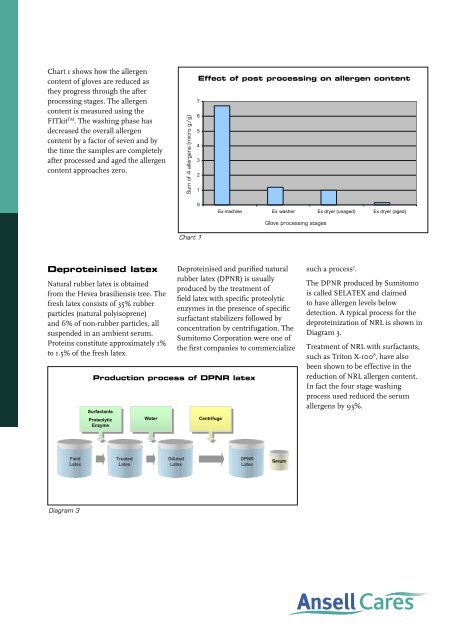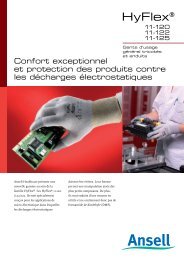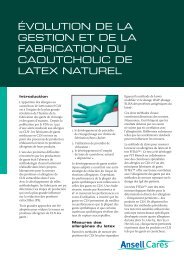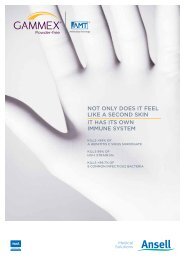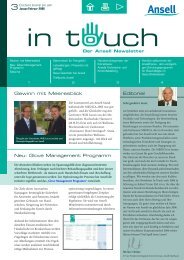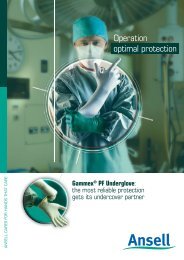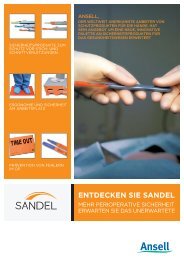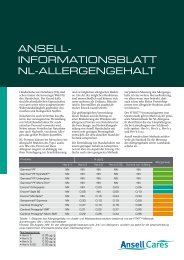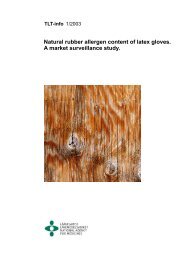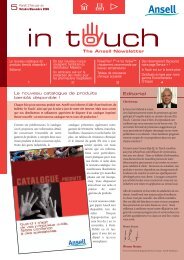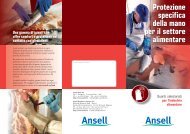Download full document - Ansell Healthcare Europe
Download full document - Ansell Healthcare Europe
Download full document - Ansell Healthcare Europe
You also want an ePaper? Increase the reach of your titles
YUMPU automatically turns print PDFs into web optimized ePapers that Google loves.
Chart 1 shows how the allergen<br />
content of gloves are reduced as<br />
they progress through the after<br />
processing stages. The allergen<br />
content is measured using the<br />
FITkit TM . The washing phase has<br />
decreased the overall allergen<br />
content by a factor of seven and by<br />
the time the samples are completely<br />
after processed and aged the allergen<br />
content approaches zero.<br />
Deproteinised latex<br />
Natural rubber latex is obtained<br />
from the Hevea brasiliensis tree. The<br />
fresh latex consists of 35% rubber<br />
particles (natural polyisoprene)<br />
and 6% of non-rubber particles, all<br />
suspended in an ambient serum.<br />
Proteins constitute approximately 1%<br />
to 1.5% of the fresh latex.<br />
�����<br />
�����<br />
Diagram 3<br />
�����������<br />
�����������<br />
������<br />
�������<br />
�����<br />
�������<br />
�����<br />
Sum ���of �� 4 �allergens ���������(micro ������ g/g) ����<br />
Effect of post processing on allergen content<br />
�<br />
�<br />
�<br />
�<br />
�<br />
�<br />
�<br />
�<br />
Chart 1<br />
Production process of DPNR latex<br />
����� ����������<br />
���������� �� ������ ����������������� �� ����� ������<br />
����<br />
�����<br />
Glove processing stages<br />
Deproteinised and purified natural<br />
rubber latex (DPNR) is usually<br />
produced by the treatment of<br />
field latex with specific proteolytic<br />
enzymes in the presence of specific<br />
surfactant stabilizers followed by<br />
concentration by centrifugation. The<br />
Sumitomo Corporation were one of<br />
the first companies to commercialize<br />
�����<br />
such a process 7 .<br />
The DPNR produced by Sumitomo<br />
is called SELATEX and claimed<br />
to have allergen levels below<br />
detection. A typical process for the<br />
deproteinization of NRL is shown in<br />
Diagram 3.<br />
Treatment of NRL with surfactants,<br />
such as Triton X-100 8 , have also<br />
been shown to be effective in the<br />
reduction of NRL allergen content.<br />
In fact the four stage washing<br />
process used reduced the serum<br />
allergens by 93%.


